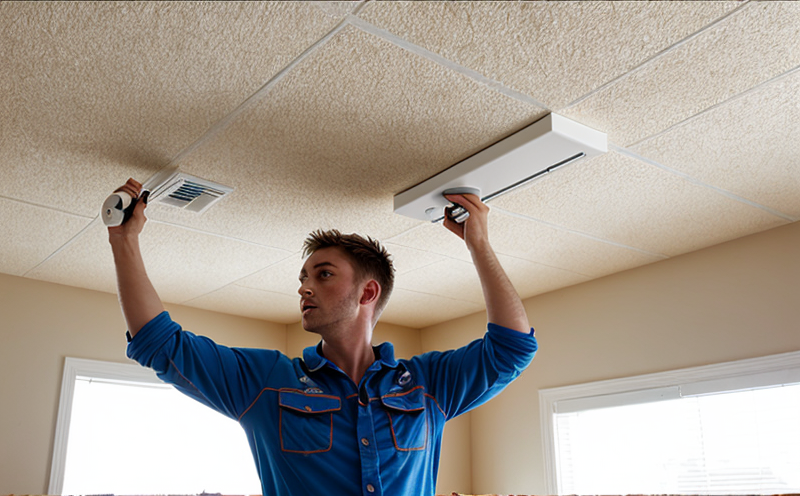Acoustic ceiling inspection
The acoustic ceiling inspection is a critical procedure in construction and building projects aimed at ensuring that the installed ceilings meet specific performance criteria related to sound insulation, noise reduction, and overall acoustical quality. This service ensures that the installed materials and design choices provide an optimal environment for reducing unwanted sounds within a space.
Acoustic ceilings play a pivotal role in enhancing comfort and well-being by minimizing noise pollution and creating a more pleasant acoustic environment. In commercial buildings such as offices, hospitals, schools, and retail spaces, the quality of sound insulation can significantly impact occupant satisfaction and productivity. In residential settings, it helps in achieving better sleep and stress reduction.
The process involves several key steps including material selection, installation, and final inspection. The materials used for acoustic ceilings are chosen based on their ability to absorb sound effectively. Common materials include mineral wools, glass wool, and specialized acoustic panels. These materials are typically installed between the structural ceiling and the plasterboard or drywall finish.
During the inspection process, a range of tests is conducted to evaluate the performance of the installed ceilings. The most important metrics for acoustic insulation include the Noise Reduction Coefficient (NRC) and Sound Absorption Coefficient (SAC). These measurements help in determining how well the ceiling can absorb sound from one room to another, thereby reducing noise levels.
For a comprehensive inspection, various instruments are employed such as sound level meters, octave band analyzers, and reverberation time meters. These tools provide precise data on the acoustic properties of the installed ceilings. The testing process is typically carried out in accordance with international standards like ISO 140-3:2007 for sound insulation.
The importance of acoustic ceiling inspection cannot be overstated, especially in high-density areas where noise control is crucial. It ensures that buildings meet the necessary regulatory requirements and provides a healthier living or working environment. Compliance with industry standards such as ISO 140-3:2007 not only enhances the comfort of occupants but also contributes to energy efficiency by reducing the need for artificial lighting in well-insulated spaces.
Moreover, acoustic ceilings contribute significantly to sustainable construction practices by reducing noise pollution and supporting better indoor air quality. By adhering to strict inspection protocols, builders can ensure that their projects meet not only local regulations but also global standards of excellence in acoustics.
Why It Matters
The acoustic ceiling inspection is essential for several reasons, particularly within the construction and building sector. Firstly, it ensures that buildings comply with international acoustic performance criteria set by organizations like ISO and ASTM. These standards are crucial in guaranteeing that structures provide a suitable environment for their intended use.
Acoustic ceilings contribute to a healthier indoor environment by reducing noise levels, which can have significant health benefits such as decreased stress and improved sleep quality. In healthcare facilities, effective sound insulation is vital for patient care and privacy. In educational institutions, it supports better learning environments by minimizing distractions from external noise sources.
Furthermore, compliance with acoustic standards enhances the overall aesthetic appeal of buildings by providing a seamless finish to ceilings that blend well with other architectural elements. This integration not only improves visual aesthetics but also contributes to energy efficiency through reduced heat gain and improved thermal insulation properties.
The inspection process itself is designed to identify any discrepancies between the installed materials and those specified in the design plans. By conducting thorough inspections, potential issues can be addressed early on, saving time and resources during later stages of construction or renovation projects.
From a business perspective, meeting acoustic performance standards can lead to higher customer satisfaction rates among occupants who appreciate quieter spaces free from excessive background noise. This can translate into increased occupancy rates for commercial properties or better academic outcomes in educational institutions.
International Acceptance and Recognition
- ISO 140-3:2007 – Specifies procedures for measuring sound insulation between rooms separated by a single leaf partition wall.
- ASTM E84-15A – Provides methods for classifying building materials according to their flame spread and smoke development characteristics; while not directly related to acoustic properties, it complements other standards in ensuring comprehensive evaluation of ceiling installations.
- EN ISO 717-1:2004 – Covers the determination of sound absorption coefficients of construction products by means of reverberation chambers.
- IEC 61914-1 – Defines test methods for measuring airborne sound insulation in buildings using multiple room systems and single room systems.
The acceptance and recognition of these standards across different countries underscore their importance in achieving consistent acoustic performance worldwide. Compliance with internationally recognized guidelines ensures that construction projects meet the highest quality standards, thereby enhancing user satisfaction and safety.
Competitive Advantage and Market Impact
Incorporating advanced acoustic ceiling inspection into project specifications offers several competitive advantages for builders and architects seeking to differentiate themselves in a crowded market. By offering superior sound insulation solutions, businesses can attract clients who prioritize comfort and well-being over cost alone.
The ability to demonstrate compliance with stringent international standards such as ISO 140-3:2007 or ASTM E84-15A provides reassurance to potential customers about the reliability and quality of acoustic performance. This transparency can help build trust and credibility, leading to increased market share.
Moreover, investing in state-of-the-art inspection equipment and trained personnel allows firms to stay ahead of competitors by delivering high-quality results consistently. Such investments reflect a commitment to excellence that resonates positively with discerning clients looking for premium services.
The demand for better acoustic environments continues to grow globally as awareness about the benefits of reduced noise pollution increases. Companies that lead in this area are well-positioned to capture market segments focused on sustainability, health and wellness, and overall quality of life improvements through architectural design choices.





